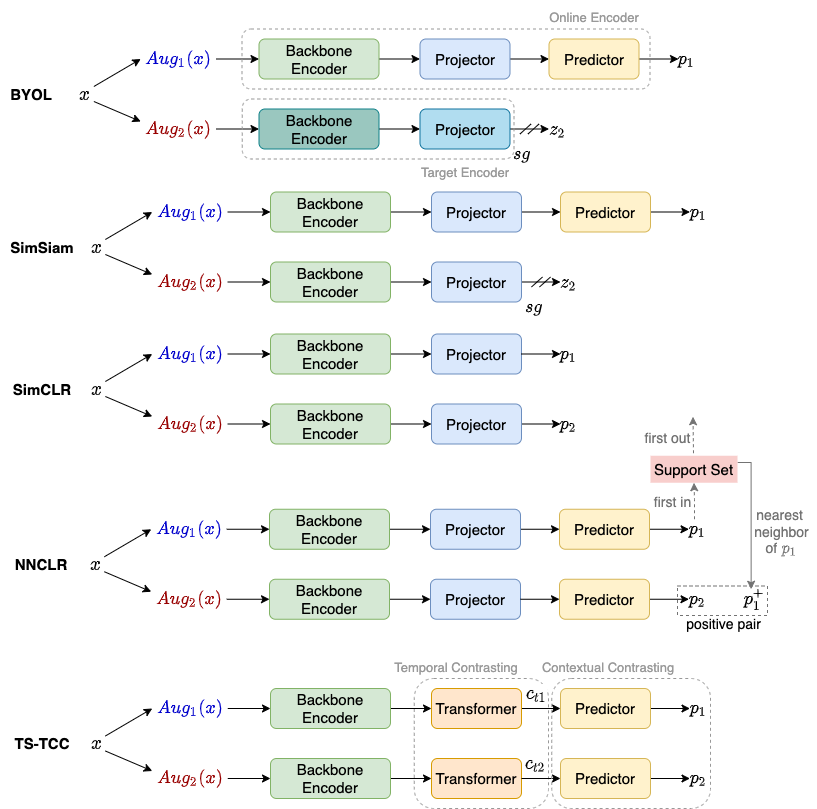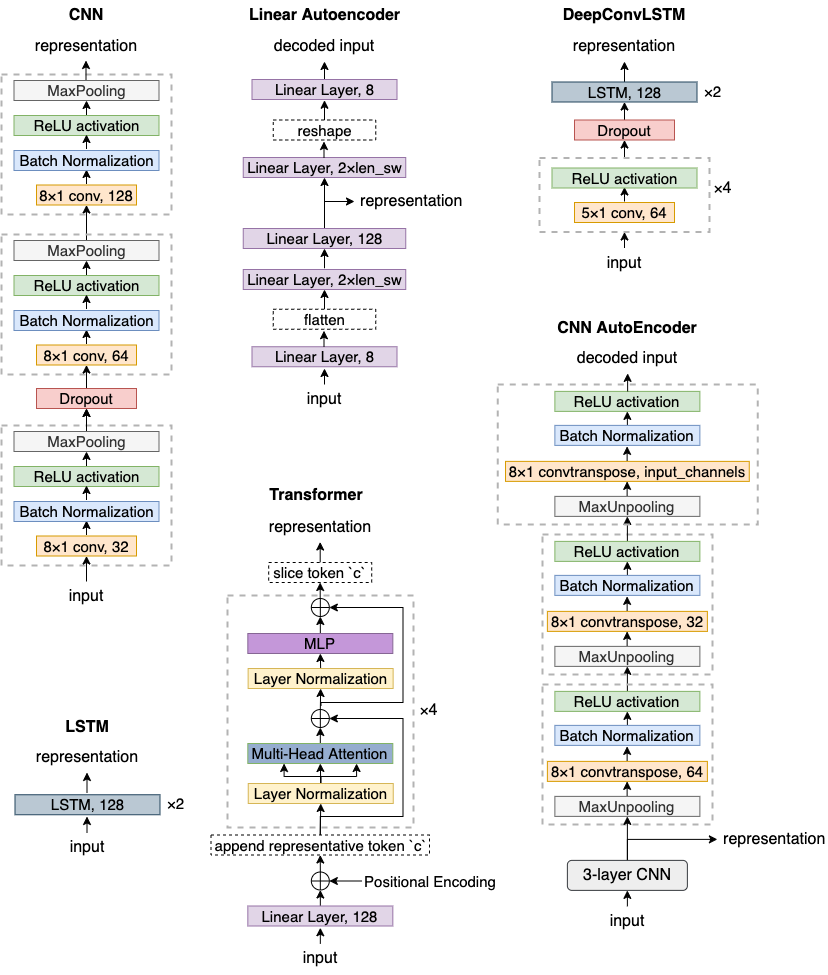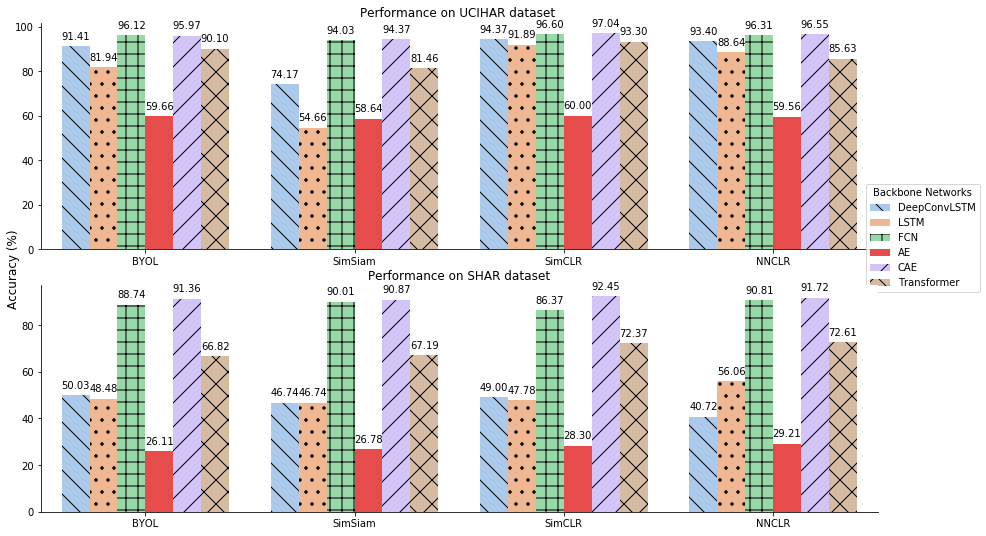CL-HAR is an open-source PyTorch library of contrastive learning on wearable-sensor-based human activity recognition (HAR). For more information, please refer to our KDD-2022 paper "What Makes Good Contrastive Learning on Small-Scale Wearable-based Tasks?".
For more of our results, please refer to results.md
To install required packages, run the following code. The current Pytorch version is 1.8.
conda create -n CL-HAR python=3.8.3
conda activate CL-HAR
pip install -r requirements.txt
For the version of torch and torchvision, we found torch==1.8.0 and torchvision==0.9.0 work fine on cuda 11.6 (Tesla V100). The version of these packages should be subject to the cuda version on your device
To train contrastive models on UCIHAR dataset, run the following script.
python main.py --framework 'byol' --backbone 'DCL' --dataset 'ucihar' --aug1 't_warp' --aug2 'negate' --n_epoch 60 --batch_size 128 --lr 5e-4 --lr_cls 0.3
python main.py --framework 'simsiam' --backbone 'DCL' --dataset 'ucihar' --aug1 't_warp' --aug2 'negate' --n_epoch 60 --batch_size 128 --lr 5e-4 --lr_cls 0.3
python main.py --framework 'simclr' --backbone 'DCL' --dataset 'ucihar' --aug1 't_warp' --aug2 'negate' --n_epoch 120 --batch_size 256 --lr 3e-3 --lr_cls 0.03
python main.py --framework 'nnclr' --backbone 'DCL' --dataset 'ucihar' --aug1 't_warp' --aug2 'negate' --n_epoch 120 --batch_size 256 --lr 3e-3 --lr_cls 0.02 --mmb_size 1024
python main.py --framework 'tstcc' --backbone 'FCN' --dataset 'ucihar' --aug1 't_warp' --aug2 'negate' --n_epoch 40 --batch_size 128 --lr 3e-4 --lr_cls 3e-4
- random
- subject
- subject_large
Refer to models/backbones.py
- FCN
- DeepConvLSTM
- LSTM
- AE
- CAE
- Transformer
To obtain supervised learning baselines of the encoder networks, you may use main_supervised_baseline.py
To train an encoder network under supervised setting, you can run the following code:
python main_supervised_baseline.py --batch_size 64 --lr 1e-4 --dataset 'ucihar' --backbone 'FCN'
python main_supervised_baseline.py --batch_size 64 --lr 1e-4 --dataset 'ucihar' --backbone 'DCL'
python main_supervised_baseline.py --batch_size 64 --lr 1e-4 --dataset 'ucihar' --backbone 'LSTM'
python main_supervised_baseline.py --batch_size 64 --lr 1e-4 --dataset 'ucihar' --backbone 'Transformer'
python main_supervised_baseline.py --lambda1 5.0 --batch_size 64 --lr 1e-4 --dataset 'ucihar' --backbone 'AE'
python main_supervised_baseline.py --lambda1 5.0 --batch_size 64 --lr 1e-4 --dataset 'ucihar' --backbone 'CNN_AE'
Refer to models/frameworks.py. For sub-modules (projectors, predictors) in the frameworks, refer to models/backbones.py
- TS-TCC
- SimSiam
- BYOL
- SimCLR
- NNCLR
- NTXent
models/loss.py - Cosine Similarity
Refer to augmentations.py
-
- noise
- scale
- negate
- perm
- shuffle
- t_flip
- t_warp
- resample
- rotation
- perm_jit
- jit_scal
-
- hfc
- lfc
- p_shift
- ap_p
- ap_f
- logger
- t-SNE
- MDS
If you find any of the codes helpful, kindly cite our paper.
@misc{qian2022makes, title={What Makes Good Contrastive Learning on Small-Scale Wearable-based Tasks?}, author={Hangwei Qian and Tian Tian and Chunyan Miao}, year={2022}, eprint={2202.05998}, archivePrefix={arXiv}, primaryClass={cs.LG} }
Part of the augmentation transformation functions are adapted from
- https://github.com/emadeldeen24/TS-TCC
- https://github.com/terryum/Data-Augmentation-For-Wearable-Sensor-Data
- https://github.com/LijieFan/AdvCL/blob/main/fr_util.py
Part of the contrastive models are adapted from
- https://github.com/lucidrains/byol-pytorch
- https://github.com/lightly-ai/lightly
- https://github.com/emadeldeen24/TS-TCC
Loggers used in the repo are adapted from


